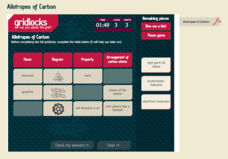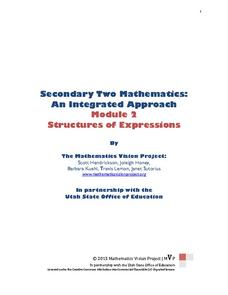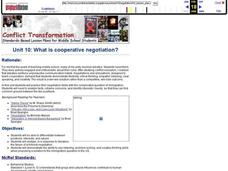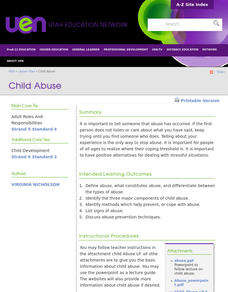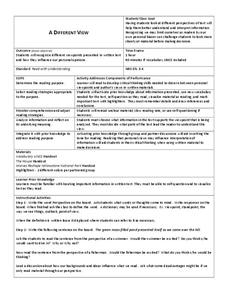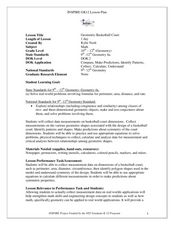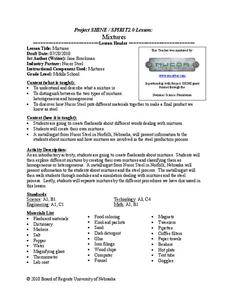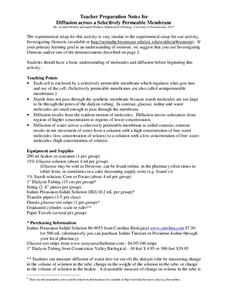University of Minnesota
Neurotransmission Model
Don't lose your marbles — you'll need them for a lesson on neurotransmission. Young scholars build a neurotransmission model using marbles, beads, rubber bands, string, and other elements. After studying specific neurotransmitters,...
Royal Society of Chemistry
Alcohols (14-16)
Ethanol, a grain alcohol, reduces emissions and conserves petroleum when mixed into gasoline. Four puzzles challenge pupils to match alcohols to their structural formulas, types of alcohol, and full oxidation products. Each puzzle...
Royal Society of Chemistry
Allotropes of Carbon
Carbon takes on many forms including diamond, graphite, and buckminsterfullerene. Scholars review their knowledge of these three allotropes of carbon as they complete four puzzles. The first acts as a general review, and the other three...
Baylor College
Need or Want?
Even as adults it can be hard to distinguish needs from wants. Using pictures of common, everyday items, children make a pocket chart separating the objects they need from those that they want. Discuss their choices, explaining that...
Mathematics Vision Project
Structures of Expressions
This comprehensive unit investigates transformations of quadratics, having learners follow "Optima" through the development and growth of her quilting business. Deftly weaving the story into the mathematical mechanics, the unit gives...
Curated OER
Explore a Family Recipe Creative Writing
Students explore the connections between food and culture by investigating the cultural influences, preparation, and historical ties of the food that people eat. They comprehend how geography and climate effects what people eat...
Curated OER
What's in GDP?
Students define GDP and collect data on a country's budget. In this economics instructional activity, students differentiate between real and nominal GDP. This activity contains an answer key to the activities.
Curated OER
Paper Chromatography
Young scholars use this design the illustrate how ink can be separated into its component chemicals using paper chromatography. They use five unknown samples of ink on pre-labeled chromatography strips are provided to students. Young...
Curated OER
What is cooperative negotiation?
Tenth graders differentiate between positions, interests, and values. For this current events lesson, 10th graders analyze, in a response to literature, the failure of a fictional negotiation. Students demonstrate the ability...
Curated OER
Mined or Grown?
Sixth graders differentiate between raw materials that are cultivated and those that are mined. They collaborate with their eighth grade peers to learn more about the mining complexities at the end of their mineral identification unit.
Curated OER
Child Abuse
Students define abuse, and identify the three major components of child abuse. They identify methods that help prevent, or cope with abuse, and prevention techniques.
Curated OER
Wildlife Study Comparison
Learners compare/contrast two studies that examine the effects of environmental contaminants on animals. They read an article, identify the components of a research study, summarize the article, and complete a matrix.
Curated OER
Anatomy and Physiology Study Questions on Immunology
In this anatomy and physiology study question worksheet, young scholars define 20 terms related to the immune system. They answer 19 short answer questions that deal with immunology, autoimmune diseases, and the components and cells...
Curated OER
A Different View
Readers need to understand how their personal view point may differ or change how they see the view point found in a written text. Third graders read two informational pieces and fill out a graphic organizer to help them differentiate...
Curated OER
Molecular Modeling Activity
Students explore the concept of molecular modeling and differentiate between saturated and unsaturated compounds. In small groups, they identify molecular formulas, complete a chart comparing alkanes, alkenes, and alkynes, and construct...
Curated OER
Apply Scientific Inquiry and Scientific Habits of Mind
Pupils review the components of the scientific inquiry method. In groups, they apply this method to various experiments they are given to complete. They also use the correct scientific habits of mind when researching different concepts.
Curated OER
To Kill a Mockingbird
Students participate in a layered curriculum unit in order to give them opportunities to master objectives. Students pick the activities and this allows a differentiated lesson to occur with many opportunities for assessment.
Curated OER
Comparing and Ordering Integers
Students compare and order integers on an umber line. In this algebra lesson, students differentiate between positive and negative numbers. They plot point in the correct order on a number line.
Curated OER
Geometric Basketball Court
Students calculate the area and perimeter of a basketball court. In this geometry activity, students differentiate between similarity and congruence of geometric objects. They test conjectures and use it to solve problems.
Curated OER
Mixtures
Students differentiate the two types of mixtures. In this chemistry lesson plan, students create their own mixture and classify them according to their type. They simulate steel production with the help of a guest speaker.
Curated OER
Diffusion Across a Selectively Permeable Membrane
Students investigate how water passes through cell membranes. In this biology lesson, students differentiate osmosis and diffusion. They illustrate the movement of water in both processes.
Achieve3000
Discriminating Phonemes
Develop the fluency of beginning readers one sound at a time with this phonemic awareness lesson. Through a series of whole-class instruction, independent practice, and collaborative learning activities, children practice...
National Wildlife Federation
Habitat Web
Young scientists weave together an understanding of ecosystems with this fun collaborative activity. Taking on the roles of different living and non-living elements of specific habitats, learners use a ball of yarn to create...
EngageNY
Grade 10 ELA Module 4: Unit 2, Lesson 5
When Macbeth says, "Nature seems dead," he uses personification. Using the resource, scholars complete a Quick Write to analyze the impact of figurative language on the mood of Shakespeare's Macbeth. Pupils also participate in an...


